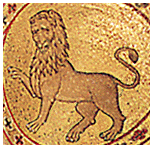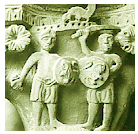...Best of Sicily
presents... Best of Sicily Magazine. ... Dedicated to Sicilian art, culture, history, people, places and all things Sicilian. |
by Carlo Trabia | ||
Magazine Best of Sicily Arts & Culture Fashion Food & Wine History & Culture About Us Travel Faqs Contact Map of Sicily |
Robert "Guiscard" de Hauteville and his knights may have come
from humbler stock than William "the Conqueror" and his companions,
but the sunny Mediterranean emirate it took them a decade to conquer was
far wealthier than the cloudier Kingdom of England William siezed from the
Saxons. It also had the advantage of being closer, geographically and socially,
to what was then a more important region --the Mediterranean World that
encompassed parts of We are referring to the prancing golden lions on a deep red field. The pose of the lions is described, more precisely, in the Norman French language of English heraldry as "passant guardant," and three of them still appear in the English section of the coat of arms used by the Queen of England. Heraldry, the systematic and hereditary use of symbols on knights' shields, originated in the middle of the twelfth century. We have no definite knowledge of the earliest Norman kings of England or Sicily using a symbol such as the lion on a shield or other personal device. (A coat of arms bearing two of these lions is attributed to Henry II, but appears on none of his seals.) The earliest surviving images of this symbol, and its close identification with one of these royal families, will be found in Sicily. The oldest ones, in the Norman Palace in Palermo, date from around 1143. The mosaic shown here is in the Throne Room (Sala di Ruggero), but others are visible over the throne in the nearby Palatine Chapel. The lion passant guardant also appears on a capital in the cloister court of Monreale, on the shields of Saracen soldiers in the service of the King of Italy, and as a repeating motif on the exterior of the apse of Palermo Cathedral. Lions were commonplace in eleventh century art and sculpture. Yet the regal beast's depiction, in precisely the same pose as that of the lion of England (its face toward the viewer, its right paw raised) cannot be a mere coincidence. But was the lion passant guardant a purely Sicilian symbol? The contemporary use of similar symbols in the Arab and Byzantine worlds, and the fact that Saracen architects designed the Sicilian cathedrals, whose mosaics reflect Greek influences, suggests that the lion was anything but native Sicilian. It also suggests that the medieval world was smaller than many of us imagined. About the Author: Catanian architect Carlo Trabia has written about medieval architecture for various magazines and professional journals. | |
Top of Page |
 The Englishman arrives in Palermo on a direct flight from London. If he's read a little about medieval Sicily,
he already knows that the Normans landed at Messina just a few years before
their conquest at Hastings, and that a few knights actually fought at both
battles. He may know that Joan, daughter of King Henry II of England, married
King William II of Sicily in 1177, bringing with her a large suite of Anglo-Normans,
and that the earliest known image of Saint Thomas Becket, the bishop Joan's
father came to detest, appears not in England but in Sicily, as a mosaic
in Monreale Abbey. In fact, Becket's family found refuge in Palermo as guests of the King of Sicily while Becket was in exile in France. But as he begins his discovery of Sicily, our Briton finds little that overtly evokes the Norman heritage he knows. The cathedrals at Palermo, Monreale and Cefalù have recognisable Norman elements, of course, but except for their cloisters they exist in a Romanesque style
altogether simpler than the ornate Gothic cathedrals of Canterbury and York.
With their battlements and dense towers, they resemble fortresses as much
as churches. And Palermo's Royal Palace, with its opulent Palatine Chapel, bears little resemblance to the austere Tower of London, with its simple chapel, or the Round Tower of Windsor Castle.
The Englishman arrives in Palermo on a direct flight from London. If he's read a little about medieval Sicily,
he already knows that the Normans landed at Messina just a few years before
their conquest at Hastings, and that a few knights actually fought at both
battles. He may know that Joan, daughter of King Henry II of England, married
King William II of Sicily in 1177, bringing with her a large suite of Anglo-Normans,
and that the earliest known image of Saint Thomas Becket, the bishop Joan's
father came to detest, appears not in England but in Sicily, as a mosaic
in Monreale Abbey. In fact, Becket's family found refuge in Palermo as guests of the King of Sicily while Becket was in exile in France. But as he begins his discovery of Sicily, our Briton finds little that overtly evokes the Norman heritage he knows. The cathedrals at Palermo, Monreale and Cefalù have recognisable Norman elements, of course, but except for their cloisters they exist in a Romanesque style
altogether simpler than the ornate Gothic cathedrals of Canterbury and York.
With their battlements and dense towers, they resemble fortresses as much
as churches. And Palermo's Royal Palace, with its opulent Palatine Chapel, bears little resemblance to the austere Tower of London, with its simple chapel, or the Round Tower of Windsor Castle. Europe, Africa
and Asia. But the Kingdom of Sicily may have given the Kingdom of England
something far more enduring than a few feudal memories. It is possible that
a symbol in the English coat of arms, so frequently visible in the United
Kingdom, was introduced at the English court by a Norman from
Sicily.
Europe, Africa
and Asia. But the Kingdom of Sicily may have given the Kingdom of England
something far more enduring than a few feudal memories. It is possible that
a symbol in the English coat of arms, so frequently visible in the United
Kingdom, was introduced at the English court by a Norman from
Sicily.